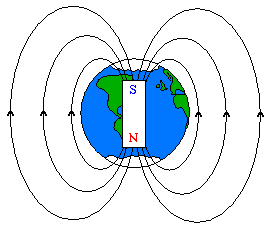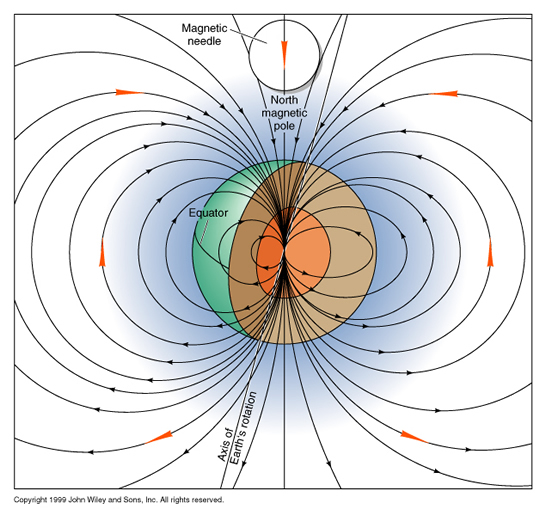Which End of a Compass Needle Points North
The Two Ends of a Magnet
After completing this section you will be able to do the following:
- Explain what a compass is and how it is affected by a magnet.
- Understand how a compass helps us to navigate on the earth.
Magnets
Most people are familiar with the general properties of magnets but are less familiar with the source of magnetism. The traditional concept of magnetism centers around the magnetic field and what is know as a dipole. Magnetic fields will be discussed in more depth later in this module, but for now the term "magnetic field" simply describes a volume of space where there is a change in energy within that volume. This change in energy can be detected and measured. The location where a magnetic field can be detected exiting or entering a material is called a magnetic pole.
Magnetic poles have never been detected in isolation but always occur in pairs, hence the name dipole. Therefore, a dipole is an object that has a magnetic pole on one end and a second, equal but opposite, magnetic pole on the other.
A bar magnet can be considered a dipole with a north pole at one end and south pole at the other. A magnetic field can be measured leaving the dipole at the north pole and returning the magnet at the south pole. If a magnet is cut in two, two magnets or dipoles are created out of one. This sectioning and creation of dipoles can continue to the atomic level. Therefore, the source of magnetism lies in the basic building block of all matter...the atom. The applets below show how magnets and their poles interact with each other.
Experiment 1
Experiment 2
Experiment 3
Importance of Magnetic Poles
What you have been observing above is the behavior of the north and south poles of a magnet. One end of any bar magnet will always want to point north if it is freely suspended. This is called the north-seeking pole of the magnet, or simply the north pole. The opposite end is called the south pole. The needle of a compass is itself a magnet, and thus the north pole of the magnet always points north, except when it is near a strong magnet. In Experiment 1, when you bring the compass near a strong bar magnet, the needle of the compass points in the direction of the south pole of the bar magnet. When you take the compass away from the bar magnet, it again points north. So, we can conclude that the north end of a compass is attracted to the south end of a magnet.
 This can be a little confusing since it would seem that what we call the North Pole of the Earth is actually its magnetically south pole. Remember that a compass is a magnet and the north pole of a magnet is attracted to the south pole of a magnet. This situation is also seen in Experiment 1 & 2. In Experiment 2, when you move the north pole of a magnet toward the south pole of the other magnet, the two magnets attract. However, in Experiment 3, when you move the south pole of a magnet toward the south pole of another magnet, the two magnets repel each other and you cannot move them together. The rule for magnetic poles is that like poles repel each other and unlike poles attract each other.
This can be a little confusing since it would seem that what we call the North Pole of the Earth is actually its magnetically south pole. Remember that a compass is a magnet and the north pole of a magnet is attracted to the south pole of a magnet. This situation is also seen in Experiment 1 & 2. In Experiment 2, when you move the north pole of a magnet toward the south pole of the other magnet, the two magnets attract. However, in Experiment 3, when you move the south pole of a magnet toward the south pole of another magnet, the two magnets repel each other and you cannot move them together. The rule for magnetic poles is that like poles repel each other and unlike poles attract each other.
Use of a Compass
Since the north seeking pole of a compass always wants to point north, then the compass could be useful in helping us navigate. With a compass we can always tell which direction is north and if you know north, then you know all of the other directions. A compass and a map are essential tools when hiking in the woods. Since the north seeking pole of the compass needle is always attracted to the north, then the earth must be like a huge magnet with a magnetic pole at each end. This is exactly the case but magnetic north is slightly different from the north axis of rotation of the earth. Scientists believe that the movement of the Earth's liquid iron core and other things are responsible for the magnetic field around the earth.

Review:
- The location where a magnetic field can be detected exiting or entering a material is called a magnetic pole.
- Magnetic poles have never been detected in isolation but always occur in pairs, hence the name dipole.
- Therefore, a dipole is an object that has a magnetic pole on one end and a second, equal but opposite, magnetic pole on the other.
- The north-seeking pole of any bar magnet will always want to point north if it is freely suspended.
Which End of a Compass Needle Points North
Source: https://www.nde-ed.org/Physics/Magnetism/twoends.xhtml